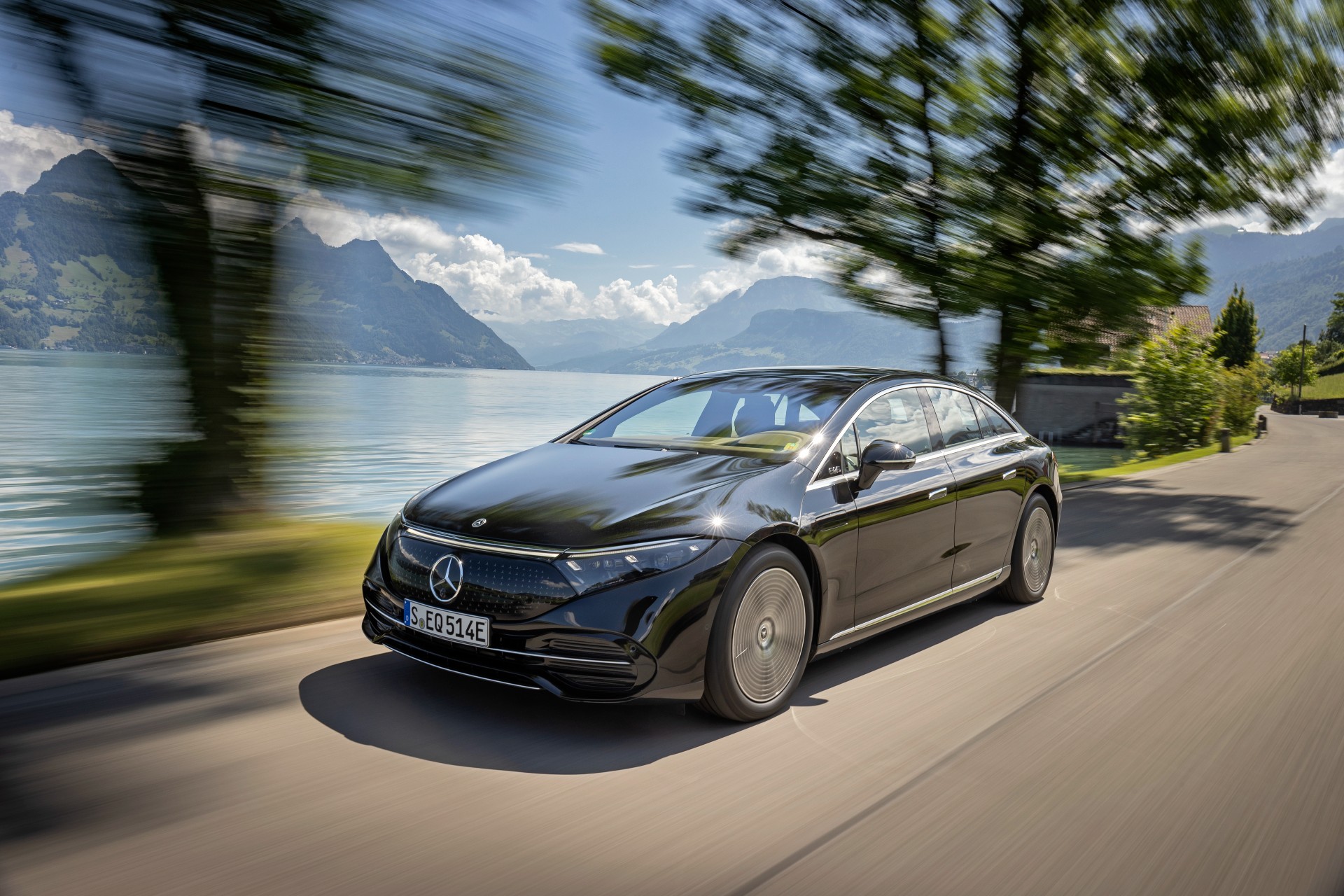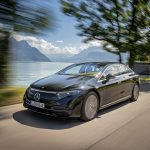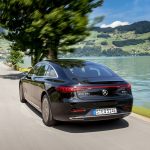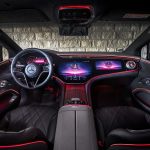Mercedes-Benz announced today that it has started accepting orders for the EQS all-electric sedan, starting at €106,374.10 for its base model. Deliveries will begin in Germany by the end of September and in the United States in Q4.
In development for several years, Mercedes-Benz unveiled the EQS on April 15th, aiming to take a stab at the EV giants who have dominated the industry. Luxurious and fast, the EQS will battle with the Tesla Model S for the top spot in the high-end luxury EV sector, but Mercedes customers will have to pay slightly more than Tesla owners will.
The Daimler-owned Mercedes released a press statement earlier today that announced the acceptance of orders for the EQS. Capable of an estimated 478 miles of all-electric range, according to WLTP ratings, the EQS has the potential to be one of the best EVs on the market in terms of miles per charge. Coupled with a top speed of 130 MPH and 516 horsepower, the EQS is a competitive EV.
Mercedes EQS EV spied benchmarking against Tesla Model S and Model 3
As the EQS will be available to customers very soon, Mercedes-Benz is also rolling out the introduction of Over-the-Air updates, which will send software fixes and new features to vehicles over the internet. Tesla owners are familiar with this functionality as the automaker regularly rolls out new software versions that equip bug fixes and new entertainment features, among plenty of other things.
Mercedes said it would offer customers a “Roaring Pulse” sound experience and several mini-games to kill time while charging. These include Tetris and Sudoku. It will be free for one year but will cost €89 annually to continue. The OTA updates will also expand to more functions in the future, according to the company. It said that:
“The range of OTA functions is being successively expanded. This means that following the purchase and initial new-car configuration, some of the features of the EQS can be adapted according to personal preferences. This also includes enabling the rear axle steering with a ten-degree steering angle. In addition to the conventional purchasing of individual functions, customers can also take out subscriptions. Temporary activations and free trial periods are also planned.”
Edition 1: A special variant for early orderers
Mercedes will also launch the Edition 1 variant of the EQS, an optional upgrade to the vehicle. It won’t be free and will tack on €18,433.10 onto the price, but will add the AMG line, 21-inch wheels, and several interior and exterior cosmetic features.
- Interior
- AMG Line exterior
- Metallic paint obsidian black
- Panoramic sliding sunroof
- 3 cm (21-inch) AMG multi-spoke light-alloy wheels
- “Edition 1” badge in the window triangles in front of the outside mirrors
- Exterior
- Designo nappa leather upholstery in neva grey/reflex blue
- Luxury seats including 4-way lumbar support and contour lighting
- Multicontour seats for driver and front passenger
- Upper instrument panel and beltlines in nappa-look reflex blue
- Trim elements in open-pore ship’s deck walnut wood
- Designer seat belt buckles front and rear
- Floor mats with “Edition 1” lettering and piping in reflex blue
- Door sill panels with illuminated “Edition 1” lettering in white

Credit: Mercedes Benz
Add-Ons
There is no shortage of add-ons for the EQS, and Mercedes details them greatly. From Intelligent Park Pilot, an “autopark-like” feature, to Air Control Plus that utilizes a HEPA air filter for air quality, there are several additional options to make the EQS well-rounded. You will pay extra for these features, though, and they could add up.
Intelligent Park Pilot
For €1,844.50, the EQS can be outfitted with Intelligent Park Pilot, which benefits valet functions and can park automatically without a driver controlling the car.
“Pre-installation for the INTELLIGENT PARK PILOT is part of the Parking Package with remote parking functions (1844.50 euros1). This prepares the EQS for automated valet service (AVP, SAE level 4). Together with the required special equipment and the corresponding Connect service, the vehicle has the onboard technology to park and unpark fully automatically without driver involvement. This is conditional upon car parks being equipped with AVP infrastructure and national legislation allowing such operations. The Connect service has specific features depending on the country.”
Energizing Air Control Plus
For an additional €535.50, Mercedes-Benz will take a “holistic approach” with the EQS to increase the cabin’s air quality.
“Mercedes-Benz takes a holistic approach to air quality in the EQS. The system is based on filtration, sensors, a display concept and air conditioning. The HEPA (High Efficiency Particulate Air) filter has a very high filtration level that enables it to trap particulate matter, micro-particles, pollen and other substances that enter with the outside air. An activated carbon coating reduces sulphur dioxide and nitrogen oxides as well as odours in the interior. The interior air filter has been granted 2021 “OFI CERT” ZG 250-1 certification from the Austrian Research and Testing Institute (OFI) for viruses and bacteria. Using pre-entry climate control, it is also possible to clean the interior air before getting into the vehicle. The particulate levels outside and inside the vehicle are also displayed in MBUX. They can be viewed in detail in the dedicated Air Quality menu.”.
Driver Assistance Packages
Mercedes is also highlighting its Advanced and Advanced Plus Driver Assistance packages that will increase safety for drivers and passengers. Basic features like Lane Keeping Assist and Blind Spot Assist are included in these packages.
Advanced Package
Tacking on €2,082.50, the Advanced Package adds several interesting features that improve safety and functionality for driving.
“The Advanced Package (2082.50 euros1) includes the Assistance Package with the three driving assistance systems Active Distance Assist DISTRONIC, Active Lane Keeping Assist and Blind Spot Assist. Other components include MBUX Augmented Reality Navigation, illuminated door sill panels with Mercedes-Benz lettering and a stowage compartment under the centre console.”
Advanced Plus Package
An extra €7,021 will add the Advanced Package, plus some other supplemental features.
“The Advanced Plus package (7021 euros1) includes the Driving Assistance package Plus[5], the Parking Package with 360° camera and DIGITAL LIGHT in addition to the Advanced Package. DIGITAL LIGHT has a light module with three extremely powerful LEDs in each headlamp, whose light is refracted and directed by 1.3 million micro-mirrors. The revolutionary headlamp technology can also project guide markings or warning symbols onto the road. Two assistance functions[6] are new: the EQS can indicate the start of a cooperative lane change and warn or give a directional instruction if Lane Keeping Assist or Blind Spot Assist detects a hazard.”
What do you think? Let us know in the comments below, or be sure to email me at joey@teslarati.com or on Twitter @KlenderJoey.

News
Tesla China quietly posts Robotaxi-related job listing
Tesla China is currently seeking a Low Voltage Electrical Engineer to work on circuit board design for the company’s autonomous vehicles.

Tesla has posted a new job listing in Shanghai explicitly tied to its Robotaxi program, fueling speculation that the company is preparing to launch its dedicated autonomous ride-hailing service in China.
As noted in the listing, Tesla China is currently seeking a Low Voltage Electrical Engineer to work on circuit board design for the company’s autonomous vehicles.
Robotaxi-specific role
The listing, which was shared on social media platform X by industry watcher @tslaming, suggested that Tesla China is looking to fill the role urgently. The job listing itself specifically mentions that the person hired for the role will be working on the Low Voltage Hardware team, which would design the circuit boards that would serve as the nervous system of the Robotaxi.
Key tasks for the role, as indicated in the job listing, include collaboration with PCB layout, firmware, mechanical, program management, and validation teams, among other responsibilities. The role is based in Shanghai.
China Robotaxi launch
China represents a massive potential market for robotaxis, with its dense urban centers and supportive policies in select cities. Tesla has limited permission to roll out FSD in the country, though despite this, its vehicles have been hailed as among the best in the market when it comes to autonomous features. So far, at least, it appears that China supports Tesla’s FSD and Robotaxi rollout.
This was hinted at in November, when Tesla brought the Cybercab to the 8th China International Import Expo (CIIE) in Shanghai, marking the first time that the autonomous two-seater was brought to the Asia-Pacific region. The vehicle, despite not having a release date in China, received a significant amount of interest among the event’s attendees.
Elon Musk
Elon Musk and Tesla AI Director share insights after empty driver seat Robotaxi rides
The executives’ unoccupied tests hint at the rapid progress of Tesla’s unsupervised Robotaxi efforts.

Tesla CEO Elon Musk and AI Director Ashok Elluswamy celebrated Christmas Eve by sharing personal experiences with Robotaxi vehicles that had no safety monitor or occupant in the driver’s seat. Musk described the system’s “perfect driving” around Austin, while Elluswamy posted video from the back seat, calling it “an amazing experience.”
The executives’ unoccupied tests hint at the rapid progress of Tesla’s unsupervised Robotaxi efforts.
Elon and Ashok’s firsthand Robotaxi insights
Prior to Musk and the Tesla AI Director’s posts, sightings of unmanned Teslas navigating public roads were widely shared on social media. One such vehicle was spotted in Austin, Texas, which Elon Musk acknowleged by stating that “Testing is underway with no occupants in the car.”
Based on his Christmas Eve post, Musk seemed to have tested an unmanned Tesla himself. “A Tesla with no safety monitor in the car and me sitting in the passenger seat took me all around Austin on Sunday with perfect driving,” Musk wrote in his post.
Elluswamy responded with a 2-minute video showing himself in the rear of an unmanned Tesla. The video featured the vehicle’s empty front seats, as well as its smooth handling through real-world traffic. He captioned his video with the words, “It’s an amazing experience!”
Towards Unsupervised operations
During an xAI Hackathon earlier this month, Elon Musk mentioned that Tesla owed be removing Safety Monitors from its Robotaxis in Austin in just three weeks. “Unsupervised is pretty much solved at this point. So there will be Tesla Robotaxis operating in Austin with no one in them. Not even anyone in the passenger seat in about three weeks,” he said. Musk echoed similar estimates at the 2025 Annual Shareholder Meeting and the Q3 2025 earnings call.
Considering the insights that were posted Musk and Elluswamy, it does appear that Tesla is working hard towards operating its Robotaxis with no safety monitors. This is quite impressive considering that the service was launched just earlier this year.
Elon Musk
Starlink passes 9 million active customers just weeks after hitting 8 million
The milestone highlights the accelerating growth of Starlink, which has now been adding over 20,000 new users per day.

SpaceX’s Starlink satellite internet service has continued its rapid global expansion, surpassing 9 million active customers just weeks after crossing the 8 million mark.
The milestone highlights the accelerating growth of Starlink, which has now been adding over 20,000 new users per day.
9 million customers
In a post on X, SpaceX stated that Starlink now serves over 9 million active users across 155 countries, territories, and markets. The company reached 8 million customers in early November, meaning it added roughly 1 million subscribers in under seven weeks, or about 21,275 new users on average per day.
“Starlink is connecting more than 9M active customers with high-speed internet across 155 countries, territories, and many other markets,” Starlink wrote in a post on its official X account. SpaceX President Gwynne Shotwell also celebrated the milestone on X. “A huge thank you to all of our customers and congrats to the Starlink team for such an incredible product,” she wrote.
That growth rate reflects both rising demand for broadband in underserved regions and Starlink’s expanding satellite constellation, which now includes more than 9,000 low-Earth-orbit satellites designed to deliver high-speed, low-latency internet worldwide.
Starlink’s momentum
Starlink’s momentum has been building up. SpaceX reported 4.6 million Starlink customers in December 2024, followed by 7 million by August 2025, and 8 million customers in November. Independent data also suggests Starlink usage is rising sharply, with Cloudflare reporting that global web traffic from Starlink users more than doubled in 2025, as noted in an Insider report.
Starlink’s momentum is increasingly tied to SpaceX’s broader financial outlook. Elon Musk has said the satellite network is “by far” the company’s largest revenue driver, and reports suggest SpaceX may be positioning itself for an initial public offering as soon as next year, with valuations estimated as high as $1.5 trillion. Musk has also suggested in the past that Starlink could have its own IPO in the future.













